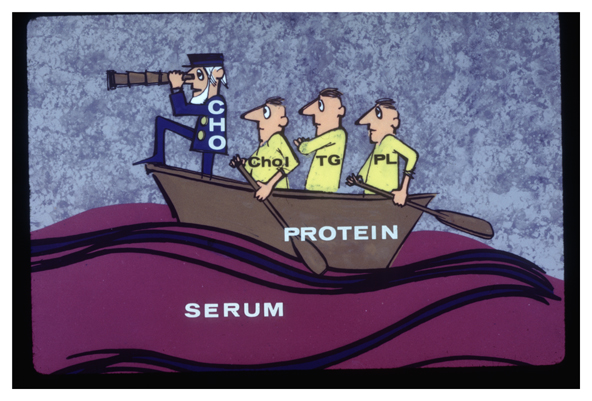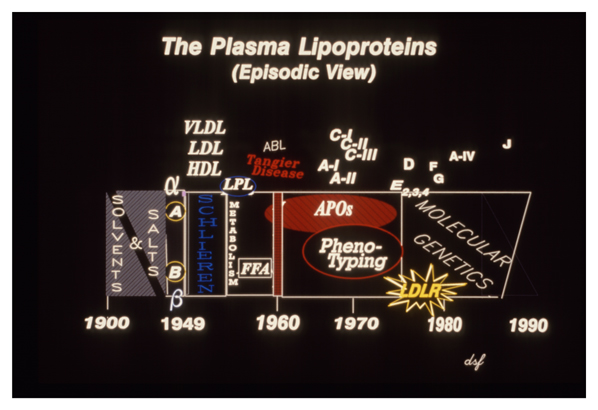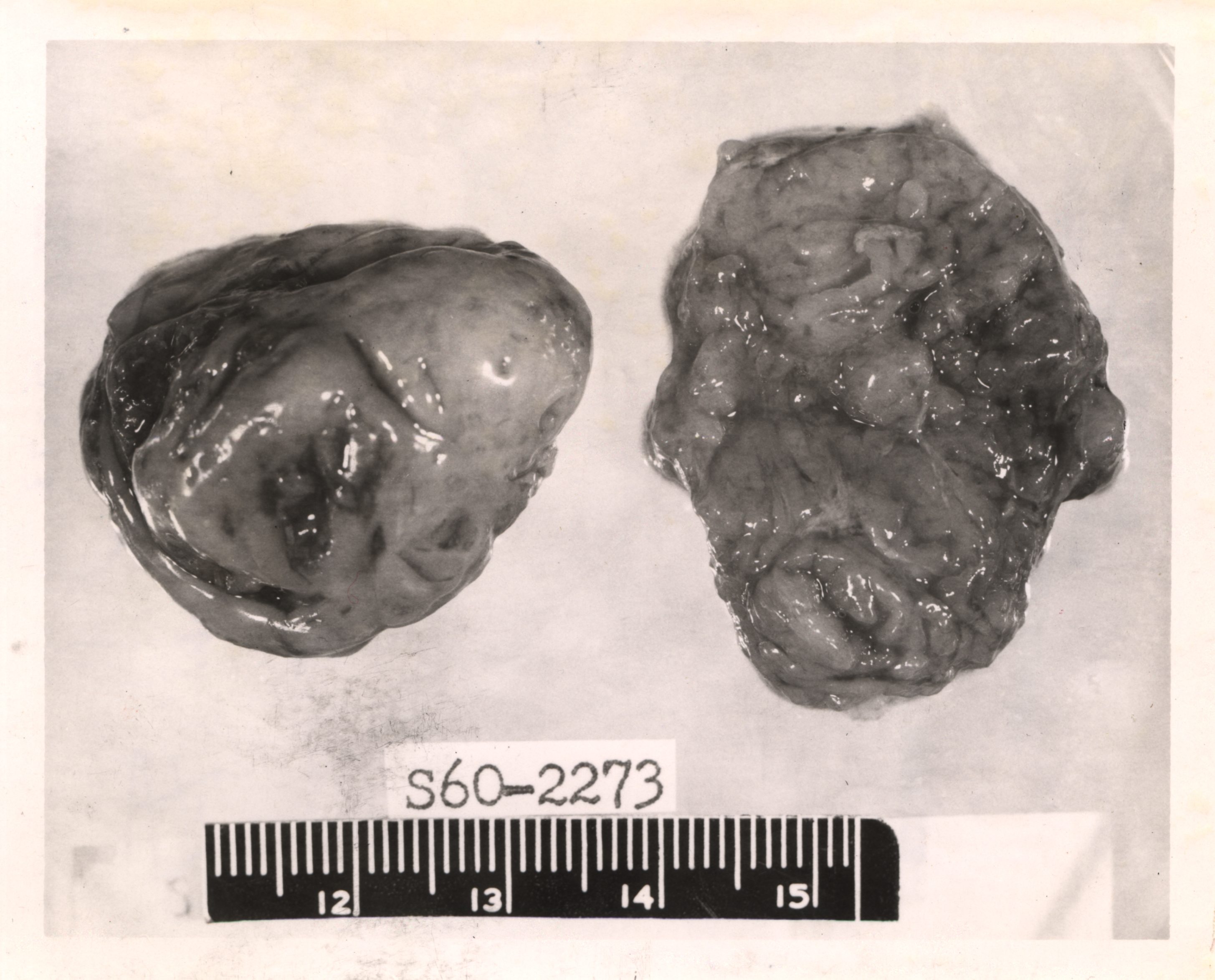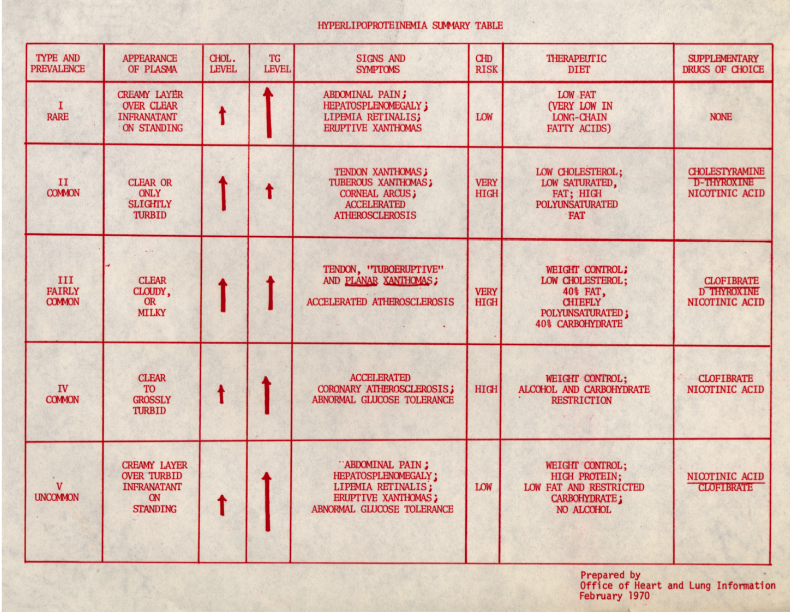Lipoprotein disorders historical perspective
|
Lipoprotein Disorders Microchapters |
Editor-In-Chief: C. Michael Gibson, M.S., M.D. [1]; Associate Editor(s)-in-Chief: Rim Halaby, M.D. [2]
Overview
From the early 1950s onward, Fredrickson specialized in the study of plasma lipoproteins, compounds of proteins and lipids which transport lipids in the blood. However, the study of lipids in the blood has started early in the 1900's. In 1949, Faraday Society in Birmingham organized the first symposium on lipoproteins and separated for the first time lipoproteins into alpha and beta types. More progress on the understanding of the nature and function of lipoprotein continued throughout the years, and in 1970 Fredrickson classified the lipids in the blood as different types of lipoproteins in the famous "Fredrickson classification" which shifted the traditional name of hyperlipidemia into hyperlipoproteinemia. Since then, more and more studies were conducted on lipoproteins which lead to the discovery of lipoprotein receptors, enzymes and genes and the association between the levels of specific lipoprotein levels and cardiovascular risks and mortality.[1]
Historical Perspective
- In 1901, Nerking reported that the removal of lipids necessitates proteolysis.[2]
- In 1920, Macheboeuf succeeded to precipitate lipid-protein complex following the treatment of horse serum by ammonium sulfate.[3][4]
- In 1949, Faraday Society in Birmingham organized the first symposium on lipoproteins and separated for the first time lipoproteins into alpha and beta types.
- In 1949, John Gofman was the first to classify lipoproteins by ultracentrifugal studies and he suggested the association between lipoprotein levels and atherosclerosis.[5]
- In 1951, an association between low levels of alpha lipoproteins and CAD risks was suggested.[6]
- In 1960, studies about abetalipoproteinemia and Tangier disease initiated the search for specific lipoproteins.
- In 1970, Fredrickson classified the lipids in the blood as different types of lipoproteins in the famous "Fredrickson classification" which shifted the traditional name of hyperlipidemia into hyperlipoproteinemia. The classification was based according the electophoretic patterns of the lipoproteins.
- Since then, more and more discoveries about lipids and lipoproteins are being recorded, such as involved genes, receptors and enzymes. In addition, a lot of focus was drawn towards the association between lipoprotein disorders and cardiovascular risks which stimulated a lot of researchers to study novel drugs that can treat lipoprotein disorders and hence decrease cardiovascular mortality.[1]
- Shown below is a figurative illustration of a lipoprotein from 1954.
- Shown below is an image depicting the history of lipoproteins. As Fredrickson illustrates with this lecture slide, the knowledge of plasma lipoproteins expanded greatly between the early 1950s, when he first illustrated the nature of plasma lipoproteins (see lecture slide entitled "Figurative illustration of a lipoprotein", from 1954), and the 1990s. He used this slide for the National Institutes of Health's first Donald S. Fredrickson lecture, "Phenotyping: On Reaching Base Camp (1950-1975)," which Fredrickson himself delivered in 1993.
- Shown below is an image depicting enlarged tonsils used to study Tangier disease.
- Shown below is an image depicting a summary table of hyperlipoproteinemia prepared in 1970.
- Shown below is an image depicting lipoprotein disorders as understood in 1950.
- Shown below is an image depicting lipoprotein disorders as understood in 1970.
- Shown below is an image depicting an awareness campaign for high cholesterol content in eggs in 1970.
References
- ↑ 1.0 1.1 Fredrickson DS (1993). "Phenotyping. On reaching base camp (1950-1975)". Circulation. 87 (4 Suppl): III1–15. PMID 8462175.
- ↑ Nerking J: Ueber Fethveissverbindungen. Arch Ges Physiol 1901;85:330-344
- ↑ Macheboeuf M: Recherches sur les phosphoaminolipides et lesSt&rides du serum et du plasma sanguins: I. Entrainement desphospholipides, des sterols et des s&ides par les diverses frac-tions au tours du fractionnement des protiides du serum. BUN SotChim Biol 1929;11:268-293
- ↑ Macheboeuf MA: Recherches sur les phosphoaminolipides et less&ides du serum et du plasma sanguins: II. Etude physico-chimique de la fraction proteique la plusriche en phospholipideset en s&ides. Bull Sot Chim Biol 1929;11:485-5038. Bennhold H: Ueber die vehikelfunction der serumeiweiskorper.Ergebn Inn Med 193242~273-3759. Blix G, Tiselius A, Svensson H: Lipids and polysaccharides inelectrophoretically separated blood serum proteins. J Biol Chem1941;137:485-494
- ↑ GOFMAN JW, LINDGREN FT, ELLIOTT H (1949). "Ultracentrifugal studies of lipoproteins of human serum". J Biol Chem. 179 (2): 973–9. PMID 18150027.
- ↑ JONES HB, GOFMAN JW, LINDGREN FT, LYON TP, GRAHAM DM, STRISOWER B; et al. (1951). "Lipoproteins in atherosclerosis". Am J Med. 11 (3): 358–80. PMID 14877839.






